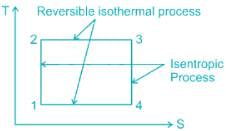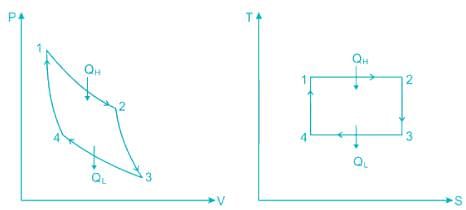SSC Exam > SSC Questions > The four process of the Carnot cycles area)T...
Start Learning for Free
The four process of the Carnot cycles are
- a)Two reversible adiabatic and two reversible isobaric process
- b)Two reversible isothermal and two reversible adiabatic process
- c)All four are isentropic processes
- d)Two reversible isochoric processes and two reversible isobaric processes
Correct answer is option 'B'. Can you explain this answer?
| FREE This question is part of | Download PDF Attempt this Test |
Verified Answer
The four process of the Carnot cycles area)Two reversible adiabatic a...
Carnot cycle consists of two reversible isothermal processes and two isentropic processes.

View all questions of this test

Carnot cycle is one of the best-known reversible cycles. The Carnot cycle is composed of four reversible processes.
- Reversible Isothermal Expansion (process 1-2)
- Reversible adiabatic expansion (process 2-3)
- Reversible isothermal compression (process 3-4)
- Reversible adiabatic compression (process 4-1)

Fig. P-V and T-S diagrams of Carnot Cycle
Most Upvoted Answer
The four process of the Carnot cycles area)Two reversible adiabatic a...
The correct answer is option 'B': Two reversible isothermal and two reversible adiabatic processes.
Explanation:
Carnot cycle is a theoretical thermodynamic cycle that consists of four processes: two isothermal processes and two adiabatic processes. Let's understand each process in detail:
1. Isothermal Process:
- In an isothermal process, the temperature of the system remains constant.
- During this process, heat is added or removed from the system to maintain the constant temperature.
- The heat transfer occurs at a constant temperature, resulting in a change in the system's internal energy.
- In the Carnot cycle, two isothermal processes are involved, one at a higher temperature (T1) and the other at a lower temperature (T2).
2. Adiabatic Process:
- An adiabatic process is a process in which there is no heat transfer between the system and its surroundings.
- In this process, the system's internal energy changes due to work done on or by the system.
- The temperature of the system can change during an adiabatic process.
- In the Carnot cycle, two adiabatic processes are involved, one where the gas expands (cooling) and the other where the gas is compressed (heating).
So, in the Carnot cycle, the four processes are as follows:
- Process 1: Isothermal expansion (heat added at T1)
- Process 2: Adiabatic expansion (no heat transfer)
- Process 3: Isothermal compression (heat removed at T2)
- Process 4: Adiabatic compression (no heat transfer)
Hence, the correct answer is option 'B': Two reversible isothermal and two reversible adiabatic processes.
Explanation:
Carnot cycle is a theoretical thermodynamic cycle that consists of four processes: two isothermal processes and two adiabatic processes. Let's understand each process in detail:
1. Isothermal Process:
- In an isothermal process, the temperature of the system remains constant.
- During this process, heat is added or removed from the system to maintain the constant temperature.
- The heat transfer occurs at a constant temperature, resulting in a change in the system's internal energy.
- In the Carnot cycle, two isothermal processes are involved, one at a higher temperature (T1) and the other at a lower temperature (T2).
2. Adiabatic Process:
- An adiabatic process is a process in which there is no heat transfer between the system and its surroundings.
- In this process, the system's internal energy changes due to work done on or by the system.
- The temperature of the system can change during an adiabatic process.
- In the Carnot cycle, two adiabatic processes are involved, one where the gas expands (cooling) and the other where the gas is compressed (heating).
So, in the Carnot cycle, the four processes are as follows:
- Process 1: Isothermal expansion (heat added at T1)
- Process 2: Adiabatic expansion (no heat transfer)
- Process 3: Isothermal compression (heat removed at T2)
- Process 4: Adiabatic compression (no heat transfer)
Hence, the correct answer is option 'B': Two reversible isothermal and two reversible adiabatic processes.

|
Explore Courses for SSC exam
|

|
Similar SSC Doubts
The four process of the Carnot cycles area)Two reversible adiabatic and two reversible isobaric processb)Two reversible isothermal and two reversible adiabatic processc)All four are isentropic processesd)Two reversible isochoric processes and two reversible isobaric processesCorrect answer is option 'B'. Can you explain this answer?
Question Description
The four process of the Carnot cycles area)Two reversible adiabatic and two reversible isobaric processb)Two reversible isothermal and two reversible adiabatic processc)All four are isentropic processesd)Two reversible isochoric processes and two reversible isobaric processesCorrect answer is option 'B'. Can you explain this answer? for SSC 2024 is part of SSC preparation. The Question and answers have been prepared according to the SSC exam syllabus. Information about The four process of the Carnot cycles area)Two reversible adiabatic and two reversible isobaric processb)Two reversible isothermal and two reversible adiabatic processc)All four are isentropic processesd)Two reversible isochoric processes and two reversible isobaric processesCorrect answer is option 'B'. Can you explain this answer? covers all topics & solutions for SSC 2024 Exam. Find important definitions, questions, meanings, examples, exercises and tests below for The four process of the Carnot cycles area)Two reversible adiabatic and two reversible isobaric processb)Two reversible isothermal and two reversible adiabatic processc)All four are isentropic processesd)Two reversible isochoric processes and two reversible isobaric processesCorrect answer is option 'B'. Can you explain this answer?.
The four process of the Carnot cycles area)Two reversible adiabatic and two reversible isobaric processb)Two reversible isothermal and two reversible adiabatic processc)All four are isentropic processesd)Two reversible isochoric processes and two reversible isobaric processesCorrect answer is option 'B'. Can you explain this answer? for SSC 2024 is part of SSC preparation. The Question and answers have been prepared according to the SSC exam syllabus. Information about The four process of the Carnot cycles area)Two reversible adiabatic and two reversible isobaric processb)Two reversible isothermal and two reversible adiabatic processc)All four are isentropic processesd)Two reversible isochoric processes and two reversible isobaric processesCorrect answer is option 'B'. Can you explain this answer? covers all topics & solutions for SSC 2024 Exam. Find important definitions, questions, meanings, examples, exercises and tests below for The four process of the Carnot cycles area)Two reversible adiabatic and two reversible isobaric processb)Two reversible isothermal and two reversible adiabatic processc)All four are isentropic processesd)Two reversible isochoric processes and two reversible isobaric processesCorrect answer is option 'B'. Can you explain this answer?.
Solutions for The four process of the Carnot cycles area)Two reversible adiabatic and two reversible isobaric processb)Two reversible isothermal and two reversible adiabatic processc)All four are isentropic processesd)Two reversible isochoric processes and two reversible isobaric processesCorrect answer is option 'B'. Can you explain this answer? in English & in Hindi are available as part of our courses for SSC.
Download more important topics, notes, lectures and mock test series for SSC Exam by signing up for free.
Here you can find the meaning of The four process of the Carnot cycles area)Two reversible adiabatic and two reversible isobaric processb)Two reversible isothermal and two reversible adiabatic processc)All four are isentropic processesd)Two reversible isochoric processes and two reversible isobaric processesCorrect answer is option 'B'. Can you explain this answer? defined & explained in the simplest way possible. Besides giving the explanation of
The four process of the Carnot cycles area)Two reversible adiabatic and two reversible isobaric processb)Two reversible isothermal and two reversible adiabatic processc)All four are isentropic processesd)Two reversible isochoric processes and two reversible isobaric processesCorrect answer is option 'B'. Can you explain this answer?, a detailed solution for The four process of the Carnot cycles area)Two reversible adiabatic and two reversible isobaric processb)Two reversible isothermal and two reversible adiabatic processc)All four are isentropic processesd)Two reversible isochoric processes and two reversible isobaric processesCorrect answer is option 'B'. Can you explain this answer? has been provided alongside types of The four process of the Carnot cycles area)Two reversible adiabatic and two reversible isobaric processb)Two reversible isothermal and two reversible adiabatic processc)All four are isentropic processesd)Two reversible isochoric processes and two reversible isobaric processesCorrect answer is option 'B'. Can you explain this answer? theory, EduRev gives you an
ample number of questions to practice The four process of the Carnot cycles area)Two reversible adiabatic and two reversible isobaric processb)Two reversible isothermal and two reversible adiabatic processc)All four are isentropic processesd)Two reversible isochoric processes and two reversible isobaric processesCorrect answer is option 'B'. Can you explain this answer? tests, examples and also practice SSC tests.

|
Explore Courses for SSC exam
|

|
Signup for Free!
Signup to see your scores go up within 7 days! Learn & Practice with 1000+ FREE Notes, Videos & Tests.


















